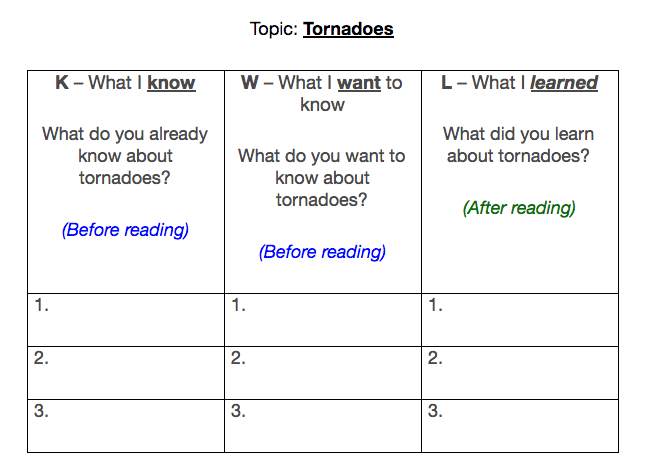Easy Way to Teach 3rd Grade Comprehension
Read At Home Everyday
Reading at home independently or aloud for enjoyment is the single best daily routine to help strengthen your child's understanding of stories. Asking simple questions about the characters and talking about best parts of a book gets your child thinking about the story and making connections to their own life.
Ask Open-ended Questions
Its easy to fall into the trap of always asking simple, straight forward questions that elicit one-word answers about your child's reading. Of course you want to make sure they're understanding what they read, so you ask questions such as "Who is the main character?"
Try asking a question that stretches your child's thinking and allows them to explain their feelings. "Did you agree with what the character did? What would you have done?"
This taps right into higher level critical thinking skills, deepening their comprehension while giving you a window into their thoughts.
K-W-L
A K-W-L chart is a popular method for teachers to hook their students and get them thinking right away about a story they're about to read.

This is best used for nonfiction reading, or books about facts. You don't have to write this all down, these questions can be used when talking with your child as they read. It's quick and easy, but will get your child diving into the topic they're learning.
Keep it Light
Conversations about books should be fun. Quizzing a child for correct answers after reading their favorite book can suck the joy out of the reading experience. Instead, try to ask questions from a place of curiously and wanting to know what your child thinks. This makes them feel that their opinions and thoughts matter.
Use the Five Finger Strategy
After reading a story use your hand to help you remember the most important elements of the story. This technique can be used for people ages 4 to 94.
- Characters – Who was in the story?
- Setting – Where did the story take place?
- Events – What happened in the story?
- End – How did the story end?
- Your Take – What was your favorite part?
CLICK HERE FOR THE FIVE FINGER RETELL PRINTABLE
Try the 5 W's to Learn Summarizing
Second Graders learn the skill of "summarizing," or retelling the main points of what they have read. Ask your child these questions to further help them remember what they have just read.
- Who – Who are the characters or people?
- What – What happened?
- Where – Where did it take place?
- When – When did it happen?
- Why – Why did the story end the way it did?
Process It
When reading with your child, a great technique is to pause after a few pages and check in to see if your child is truly grasping what they are reading. Asking open-ended questions allows them to explain their thinking. If what they tell you does not m atch the story, you can help redirect them back on track:
You: "Helen Keller's teacher wrote the word "W-A-T-E-R" into the palm of her hand as water was flowing onto her when she was 7 years old. Why did she do this?"
Your child: "I don't know….maybe it was to tickle her."
You: "Helen could not see or hear. What do you think Helen was learning when her teacher did this?"
3 Seconds of Wait Time
Allow your child enough undisturbed "think time" to process what is happening. If you ask them a question about the story, let them look at the pages and take a few moments to think, at least 3 seconds. We typically only wait one second before jumping in with the answer. Providing answers too quickly takes away a child's "thinking time", robbing them of the opportunity to fo rm conclusions on their own.
Show Evidence
As your young reader matures, they can demonstrate their understanding in more sophisticated ways. When asking them questions from the story, ask them prove their answers by showing you the pages and words that describe the event.
Use Sticky Notes to Show Your Thinking
A great way for your child to remember and internalize what they read is by using sticky notes. Have your child write these symbols on a sticky note and place them next to a line in a book to show their thinking.
LOL = funny part
? = confusing part
= favorite part
* = important part
Tame the Testing Beast
Your child will be required to take their first standardized reading test at the end of the school year. The test will contain 50 multiple choice questions.
To see sample test questions, click here .
It is helpful for parents to look through these questions and get a sense for how your child will be tested. Try practicing test questions with your child, but keep it short. Once a week read a sample passage with your child and have fun answering 2-3 questions together. Make it into a game for them to win prizes, like picking a movie for weekend. The purpose of these sessions is to (1) boost your child's confidence, (2) help parents give their child tips for answering questions, and (3) to diffuse the anxiety from testing through short practice sessions.
Different Ways to Read
Books are the best way to expose children to new vocabulary, stories and higher level thinking skills. But reading on their own is not the single way to access stories. Read alouds and audio books offer the same benefits and let children enjoy a great book. The NC Kids Digital Library offers hundreds of picture read alouds that let your child hear stories and build their reading skills.
Source: https://www.homereadinghelper.org/3rd-grade-reading-skills-reading-comprehension/
0 Response to "Easy Way to Teach 3rd Grade Comprehension"
Post a Comment